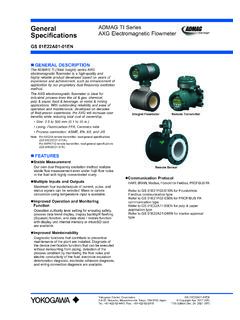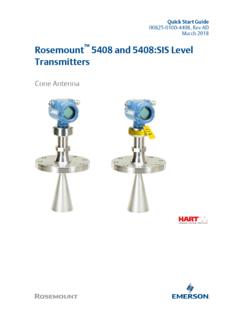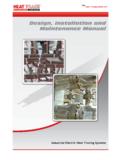Transcription of Cables and cable glands for hazardous locations
1 Cables AND cable glands FOR hazardous locations Copyright Material IEEE Paper No. PCIC (do not insert number) Brian Keane Gerhard Schwarz. Peter Thurnherr Member IEEE Member, IEEE Member, IEEE Eaton GSA Consulting thuba Ltd. 5925 McLaughlin Rd. Eberbach CH 4015 Mississauga, ON Germany Basel Canada Switzerland Abstract This paper explores the various standards and requirements for the certification, selection, use, and installation of Cables and cable glands used in explosive gas atmospheres throughout the world. International and North American requirements for Cables and cable glands will be examined and compared. In North America, the National Electrical Code (NEC) and Canadian Electrical Code, Part I (CEC) define the requirements for the types of cable that are permitted to be used in different hazardous (classified) locations . In North America, standards exist for certifying Cables for use in hazardous locations .
2 These standards have now evolved to allow for additional cable types beyond metal clad (MC) and TECK 90 Cables that are primarily used. In Canada, a new edition (2018) of the hazardous Location cable and cable gland standard has been published, and this should help to clarify the intended range of cable types that could potentially be approved for hazardous locations in Canada. In the United States (US), the NEC defines the types of Cables that can be used in hazardous locations , and UL 2225 provides the means to approve hazardous Location (HL) Cables for the US. The International Electro Technical Commission (IEC) on the other hand does not require Cables to be specifically approved for explosive gas or dust atmospheres and instead only provides guidance within IEC 60079 14 on the selection of Cables . In all jurisdictions, cable glands for use in explosive gas atmospheres are required to be approved for the location they are being installed in or with a method of protection suitable for the location that they are being installed in, but there are differences in the various standards and requirements.
3 Index Terms hazardous locations , explosive atmospheres, Cables , cable glands , hazloc, installation I. INTRODUCTION cable glands ( cable entry devices) used in hazardous locations are intended to provide the safe connection of suitable Cables to enclosures, maintaining the explosion protection and ingress properties of equipment. In North America, the NEC and the CEC prescribe the requirements for both cable glands and Cables . Both codes require the use of Cables and glands that are certified to specific standards depending on the explosive environment they are being used in. Standards used in both Canada and the US are similar in many respects, but there are some significant differences in the Cables that can be used. In jurisdictions following IEC requirements, there are product standards for hazardous location cable glands . However, unlike NEC and CEC jurisdictions, there are no specific product standards for hazardous location Cables .
4 Requirements for Cables are in IEC 60079 14: Electrical installations design, selection, and erection. IEC 60079 14 is an installation standard, not a product standard and Cables are not certified to this standard. This standard provides guidance for the minimum requirements for cable but does not define specific tests or construction specifically for hazardous location cable . Instead, wiring for ordinary locations meeting certain minimum requirements is permitted to be used. Other than in IEC 60079 14, the IEC 60079 series of standards do not address Cables . They do however address the cable glands that are used with Cables , and there are requirements in the IEC 60079 series that have construction and test requirements for the certification of cable glands . In addition to the Cables permitted by the NEC, CEC, and IEC, cable usage has also been addressed in other standards and recommended practice documents for installations offshore or on ships.
5 For example API RP14 and RP14FZ provide guidance for wiring in classified locations on fixed and floating offshore petroleum facilities. While there appear to be a wide variety of different allowances for Cables in various areas, all are considered safe by the authorities having jurisdiction in those areas. Different jurisdictions use different terminologies for areas that may contain explosive gas atmospheres. Throughout this paper, the terms hazardous locations , classified locations and areas containing explosive gas atmospheres are used interchangeably. II. EXPLOSIVE GAS ENVIRONMENTS While definitions and terminology vary slightly between the IEC, CEC, and NEC, explosive gas atmospheres, hazardous locations , or classified locations are those areas that have a likelihood of having an atmosphere that contains a flammable gas (or gasses) in a concentration that is capable of igniting and causing an explosion/deflagration.
6 Page 1 of 9978-1-5386-4270-2/18/$ 2018 IEEE2018-PCIC-0385In jurisdictions following IEC requirements, all installations are classified per the Zone system of area classification. This system divides hazardous areas for explosive gases into three zones based on the likelihood and probable duration of the explosive gas being present. All electrical equipment used in these classified areas needs to be protected using one or more methods of protection permitted for the area s classification. For Cables , there is no difference in the requirements for Zone 1 and Zone 2. All new installations in Canada since the 1998 CEC are classified per the Zone system of classification. Existing facilities are permitted to continue to use the Division classification system, or they can reclassify to the Zone system. Regardless of the type of area classification, the equipment used in Canada is often a mix of equipment types with some being certified to legacy CSA standards and others being approved to the CAN/CSA No.
7 60079 series standards. These standards are adoptions of the IEC 60079 series standards with Canadian specific deviations included. Equipment used in Zone locations is often equipment that has been approved and marked with class and division markings. Equipment used in locations that are Division classified could also be equipment that is marked with Ex methods of protection, It should be noted that in Class I Division 1 locations , only equipment approved for Class I Division 1 or intrinsically safe equipment can be used. A new table, Table 18, has been added to CSA 18 (CEC Part 1), that lists the methods of protection and the equipment permitted in hazardous locations in Canada. In the US, installations may also be classified per the Division system or the Zone system. Unlike Canada though there is no requirement to classify areas in new installations per the Zone system.
8 As there are no rules explicitly requiring the use of Zone classification, the adoption of the Zone system has been slower in the US than in Canada, and approximately 95% of installations continue to use the Division Classification [1]. As with Canada, the NEC allows a mix of equipment. However, unlike Canada, when using equipment certified as Class I and not marked with a method of protection ( not marked AExI) it would need to be additionally marked as Class I Zone 1 or Zone 2 as applicable, and a gas group equivalent to the gas groups it is listed for. For example, a piece of equipment approved and marked as Class I Groups C, D can be used in an area classified as Zone 1 IIB. The equipment needs to be and per the rules of NEC Article 505 [2], is permitted to be marked Class I Zone 1 IIB, without an AEx or method of protection marking, in addition to its Class I Group C, D marking.
9 In Canada, the marking of Zone is not recognized in the CEC installation standard so the marking would have no meaning with respect to the installation Code in Canada. In the US and Canada, there are different requirements for cable usage depending on the classification of the area that the cable will be used in III. hazardous LOCATION Cables A. Wiring Methods 1) NEC: Requirements for wiring methods are in the NEC. Class I Division 1 and 2 wiring methods are located in NEC Article 501 and Class I Zone 0, 1, and 2 wiring methods are in Article 505. Article 504 provides additional requirements for intrinsically safe wiring methods permitted in all locations . Conduit is still largely used for installations in Class I Division 1 locations in the US, however Cables are permitted for use under restricted and special conditions. Table 1 outlines the permitted wiring methods in Class I Division 1 areas.
10 Per NEC Article 501, MC HL and ITC HL are permitted to be used in Class I Division 1 areas provided they are used only in industrial establishments with restricted public access, where the conditions of maintenance and supervision ensure that only qualified persons service the installation. These Cables must have a gas/vapor tight continuous corrugated metallic sheath with an overall jacket of suitable polymeric material. MC HL Cables must have a separate equipment grounding conductor(s) per ITC HL must be installed per the requirements of Article 727. The Cables must be terminated with fittings listed for the application. Where flexible connections are needed such as at motor terminals, TC ER HL is permitted to be used with the same restriction of being used in industrial establishments with restricted public access and accessible for service only by those qualified.














